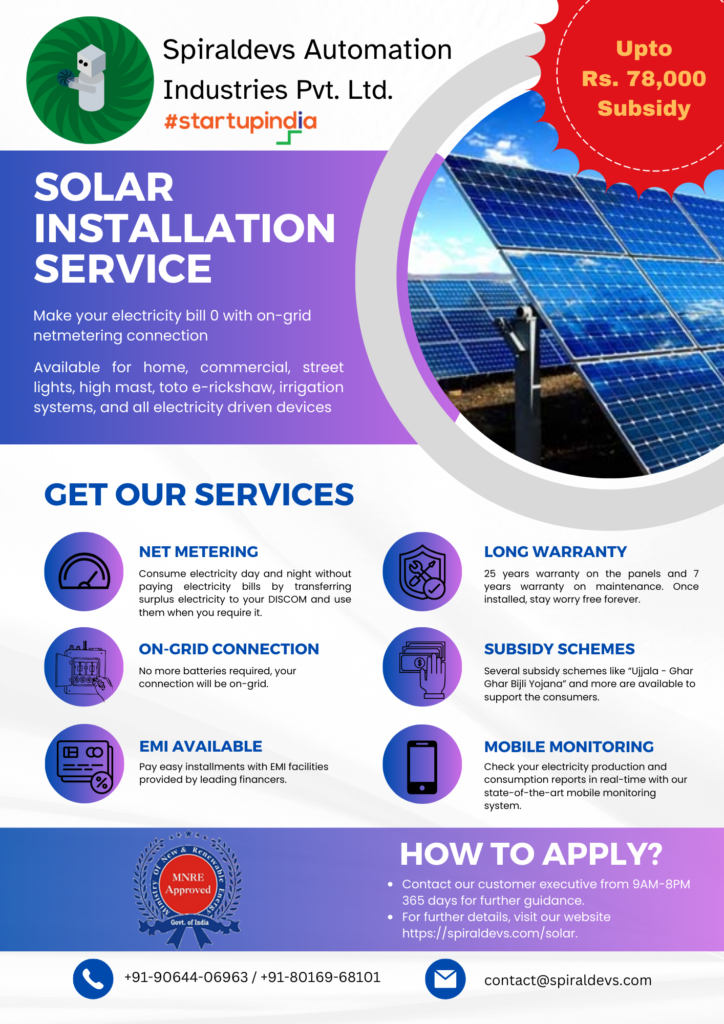Make your electricity bills Rs. 0 with our on-grid solar PV system. Exact same usage as your electricity board’s supply. Up to 25 years warranty on panels. Up to 7 years warranty on panels. Net-metering facility available. EMI available on applicable interest. Mobile monitoring system available.
Now up to Rs. 78,000/- subsidy from “PM Surya Ghar: Ghar Ghar Muft Bijlii Yojana”

Solar power, harnessed through photovoltaic cells, represents one of the most promising and sustainable sources of renewable energy available to us today. As the world grapples with the challenges posed by climate change and the need to transition away from fossil fuels, solar energy has emerged as a key player in the global energy landscape. In this comprehensive exploration, we delve into the intricacies of solar power, photovoltaic cells, and on-grid solar power systems, shedding light on their workings, advantages, and potential for widespread adoption.
Solar Power
Solar power, simply put, is the conversion of sunlight into electricity. This process relies on photovoltaic cells, also known as solar cells, which capture photons from sunlight and convert them into electrons through a phenomenon called the photovoltaic effect. These electrons are then harnessed as electric current, which can be utilized to power homes, businesses, and even entire cities.
Photovoltaic Cells
At the heart of solar power systems are photovoltaic cells. These cells are typically made from semiconductor materials such as silicon, which possess the unique property of being able to convert sunlight directly into electricity. When photons from sunlight strike the surface of a photovoltaic cell, they transfer their energy to electrons in the semiconductor material, causing them to become excited and generate an electric current.
There are several different types of photovoltaic cells, each with its own advantages and disadvantages. Monocrystalline and polycrystalline silicon cells are the most commonly used, offering high efficiency and relatively low cost. Thin-film solar cells, made from materials such as cadmium telluride or amorphous silicon, are less efficient but can be more cost-effective and flexible, making them suitable for certain applications where space is limited or weight is a concern.
On-Grid Solar Power Systems
On-grid solar power systems, also known as grid-tied or grid-connected systems, are the most common type of solar power installation in use today. These systems are connected to the electrical grid, allowing surplus electricity generated by the solar panels to be fed back into the grid for use by other consumers. Conversely, when the solar panels are not producing enough electricity to meet demand, electricity can be drawn from the grid as needed.
The key components of an on-grid solar power system include:
- Solar Panels: These are the primary components responsible for capturing sunlight and converting it into electricity. Solar panels are typically mounted on rooftops or in open spaces where they can receive maximum sunlight exposure.
- Inverter: The inverter is a critical component that converts the direct current (DC) electricity generated by the solar panels into alternating current (AC) electricity, which is used to power electrical devices and appliances in homes and businesses.
- Metering Equipment: On-grid solar power systems are equipped with meters that measure the amount of electricity generated by the solar panels and the amount of electricity consumed from the grid. This allows for accurate tracking of energy production and consumption, as well as the calculation of any excess electricity that is fed back into the grid.
- Grid Connection: On-grid solar power systems are connected to the electrical grid via a grid connection point, which allows for bi-directional flow of electricity between the solar panels and the grid. This enables seamless integration of solar power with the existing electrical infrastructure, ensuring reliability and stability of the power supply.
Advantages of On-Grid Solar Power Systems
On-grid solar power systems offer several advantages over off-grid systems and other forms of renewable energy:
- Cost-Effectiveness: On-grid solar power systems eliminate the need for expensive battery storage systems, reducing the overall cost of installation and maintenance.
- Grid Stability: By feeding surplus electricity back into the grid, on-grid solar power systems contribute to the stability and reliability of the electrical grid, particularly during peak demand periods.
- Financial Incentives: Many governments and utility companies offer financial incentives, such as feed-in tariffs and tax credits, to encourage the adoption of solar power and on-grid solar power systems.
- Environmental Benefits: On-grid solar power systems generate clean, renewable energy without producing greenhouse gas emissions or other harmful pollutants, helping to mitigate climate change and reduce air pollution.
Conclusion
Solar power, facilitated by photovoltaic cells and on-grid solar power systems, holds tremendous promise as a sustainable and environmentally friendly source of energy for the future. With ongoing advancements in technology and increasing global awareness of the need to transition to renewable energy sources, solar power is poised to play a central role in shaping the energy landscape of tomorrow. By harnessing the power of the sun, we can create a brighter, cleaner, and more sustainable future for generations to come.
